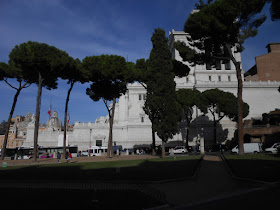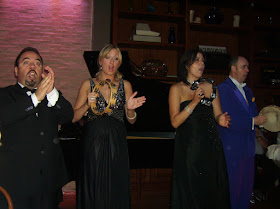Anniversary lunch at Cicerone Ristorante & Pizzeria
I ordered the Cicerone with Rocket plant and shrimp.
Arugula,
also known as salad or garden rocket, is one of the nutritious
green-leafy vegetable of Mediterranean origin.
Like as in kale, salad rocket is an excellent source of vitamin A.
Italian pronunciation: bruˈsketta
is from Italy consisting of grilled bread
rubbed with garlic and topped with olive oil and salt.
also known as salad or garden rocket, is one of the nutritious
green-leafy vegetable of Mediterranean origin.
Like as in kale, salad rocket is an excellent source of vitamin A.
For more: Health Benefits of Arugula
The arugula and shrimp were on Bruschetta.Italian pronunciation: bruˈsketta
is from Italy consisting of grilled bread
rubbed with garlic and topped with olive oil and salt.
Doug ordered the Cicerone Pizza:
Tomato, Buffalo mozzarella, pachino tomatoes, anchovies, and oregano.
I loved the salty bite of the anchovies!
For this pizza to try to duplicate this at home, I found a recipe on line for a pizza sauce.
The sauce on this pizza is fresh and has a thin consistency.
The sauce on this pizza is fresh and has a thin consistency.
I refer to Homemade Pizza Sauce from the kitchn.
Don't Cook the Sauce
This pizza sauce is to be used as soon as it's blended — no cooking needed! Spoon it right onto the pizza, cover with additional toppings, and bake. If you'd like a thicker sauce, strain the tomatoes from their juices before blending.
Ingredients
1 32-ounce can whole or diced tomatoes
6 to 8 garlic cloves, roughly chopped
2 teaspoons balsamic vinegar, plus more to taste
Salt
Fresh-cracked pepper
Olive oil
Instructions
Combine the tomatoes, garlic, vinegar, 1/2 teaspoon of salt, some black pepper, and a drizzle of olive oil in a blender or food processor. Use both the tomatoes and their juices, or drain the tomatoes for a slightly thicker and more concentrated sauce. Puree the sauce: Blend the ingredients until they're completely pureed. Stop the blender and scrape down the sides as needed. Give the sauce a taste: Taste your sauce, and add more salt, fresh-cracked pepper, or olive oil to taste. Blend a few more seconds to combine. Use the pizza sauce: This sauce is ready to be used as is — no cooking required. Just spoon it onto a round of pizza dough and use the back of the spoon to smooth it out. This amount of sauce makes enough for eight medium pizzas, depending on how much sauce you like on your pizza. Refrigerate unused sauce for up to a week. Freeze any extra pizza sauce for up to 3 months: Spoon any unused sauce into muffin tins. Freeze until solid, then pop the frozen cubes out of the mold and transfer to a freezer container. Thaw overnight before using on pizza, or microwave the cubes in 30-second bursts until they melt into a sauce.
The sauce is spooned onto a thin crust. You can make your own crust or buy prepared pizza dough.
Form the dough into a circle. Flatten the dough into a large circle with a rolling pin until you can roughly see through it.
Transfer the flattened dough onto an oiled baking tray or sheet. Use a spoon to smooth the sauce evenly across the surface.
Add the toppings.
Slice the Pachino tomatoes or cherry tomatoes in half and place on crust.
Sprinkle with freshly chopped oregano.
Form the dough into a circle. Flatten the dough into a large circle with a rolling pin until you can roughly see through it.
Transfer the flattened dough onto an oiled baking tray or sheet. Use a spoon to smooth the sauce evenly across the surface.
Add the toppings.
Slice the Italian Buffalo mozzarella or any other good fresh mozzarella cheese and place evenly on the pizza.
Add the anchovies.Slice the Pachino tomatoes or cherry tomatoes in half and place on crust.
Sprinkle with freshly chopped oregano.
How to Chop Fresh Oregano
To prepare the oregano, follow these three easy steps.
First, remove the leaves from the stem, which is not all that tasty. To remove the leaves, hold the top of the stem in one hand, and then starting near the top of the stem use your other hand to strip back the leaves moving down the stem. The move is kind of like petting a cat or dog “against the grain” (the way the hair lies). By going against the grain, the leaves should slide off with just a little pressure.
Once you have the leaves off, you want to bunch them together as tightly as you can. I think of this move like rolling a cigar. You want to get the leaves tightly packed together, so that with one move of the knife, you’re cutting through several of the leaves as once.
Now that the leaves are packed together, hold them with one hand, and then use the knife to cut through the leaves, working from one side of the “cigar” to the other. Keep the tip of the knife on the cutting board and just rotate the angle so you get through all of herbs. If you need a finer chop, just repeat the same process, and you’re good to go.
http://www.noreciperequired.com/technique/how-chop-fresh-oregano#
Bake. Place the pizza in an oven and bake at 425 F for 10-15 minutes, or until evenly browned.
"Salute."
(Which means, to you health.)
Our beautiful, romantic anniversary lunch.
Our waiter was surprised I wanted a picture of him.
He said, "Who, Me?"
I said, "Yes, you.
Photo souvenir."
We walked on down the street to find the perfect place for dessert.
Gelato is Italy’s version of ice cream,
with three major differences.
First, gelato has significantly less butterfat than ice cream’s typical 18 and 26 percent.
However, less fat does not mean less taste.
With the lower butterfat content, gelato is less solidly frozen than ice cream and melts in the mouth faster.Therefore, you taste gelato’s full flavor immediately.
Second, gelato has a much higher density than ice cream.
No air is added to gelato. The result is a higher quality dessert with a richer, creamier taste.
Third, gelato is served slightly warmer than ice cream.
Gelato is served 10 to 15 degrees warmer than ice cream.
Because it is less solidly frozen, gelato’s taste is further enhanced as it melts in the mouth.
http://caffegelato.net/whats-gelato/
Doug loves his pistachio gelato.
I opted for an expresso, delizioso!
A very tempting pasticceria caso.
On the bus for the Orientation Drive around Rome.
Views around Rome.
On to
St. Peter in Chains
San Pietro in Vincoli.
The church of San Pietro in Vincoli (St. Peter in Chains)
is named for the chains that held St. Peter when he was imprisoned in Rome and in Jerusalem.
The chains are on display in a reliquary at the confessio in front of the high altar.
The curved ceiling of the church's central nave was created in 1706.
The magnificent ceiling painting, a work from Giovanni Battista Parodi,
depicts the Miracle of the Chains.
Flanking the nave are two rows of ten massive Doric columns,
most likely taken from an ancient Roman bath or temple.
The chains of St. Peter
In the fifth century, Juvenal, the bishop of Jerusalem, gave the chains
that possibly held St. Peter while he was imprisoned in Jerusalem
to Eudoxia's mother who sent them to her daughter in Rome.
Eudoxia then gave the chains as a present to pope Leo I,
who placed them in this church,
together with the chains that had held St. Peter while he was in the Mamertine prison in Rome.
Question: "How did the apostle Peter die?"
Answer: The Bible doesn’t tell us how the apostle Peter died. The most commonly accepted church tradition is that Peter was crucified upside-down in Rome. Tradition says that, when Peter was put to death, he requested to be crucified on an inverted cross. The reason for his request was that, because he had denied his Lord, he did not consider himself worthy to die as Jesus had (see Matthew 26:33–35, 69–75). Again, this is only a tradition, and the Bible doesn’t confirm or deny the story.
What we do know for sure about Peter’s death is Jesus’ prophecy in John 21:18–19. “‘Very truly I tell you, when you were younger you dressed yourself and went where you wanted; but when you are old you will stretch out your hands, and someone else will dress you and lead you where you do not want to go.’ Jesus said this to indicate the kind of death by which Peter would glorify God.”
http://www.gotquestions.org/apostle-Peter-die.html
Michelangelo's Moses statue
On the bus for the Orientation Drive around Rome.
Views around Rome.
On to
St. Peter in Chains
San Pietro in Vincoli.
The church of San Pietro in Vincoli (St. Peter in Chains)
is named for the chains that held St. Peter when he was imprisoned in Rome and in Jerusalem.
The chains are on display in a reliquary at the confessio in front of the high altar.
The church is however best known for the statue of Moses that Michelangelo
created for the tomb of pope Julius II.
The magnificent ceiling painting, a work from Giovanni Battista Parodi,
depicts the Miracle of the Chains.
Flanking the nave are two rows of ten massive Doric columns,
most likely taken from an ancient Roman bath or temple.
The chains of St. Peter
In the fifth century, Juvenal, the bishop of Jerusalem, gave the chains
that possibly held St. Peter while he was imprisoned in Jerusalem
to Eudoxia's mother who sent them to her daughter in Rome.
Eudoxia then gave the chains as a present to pope Leo I,
who placed them in this church,
together with the chains that had held St. Peter while he was in the Mamertine prison in Rome.
Question: "How did the apostle Peter die?"
Answer: The Bible doesn’t tell us how the apostle Peter died. The most commonly accepted church tradition is that Peter was crucified upside-down in Rome. Tradition says that, when Peter was put to death, he requested to be crucified on an inverted cross. The reason for his request was that, because he had denied his Lord, he did not consider himself worthy to die as Jesus had (see Matthew 26:33–35, 69–75). Again, this is only a tradition, and the Bible doesn’t confirm or deny the story.
What we do know for sure about Peter’s death is Jesus’ prophecy in John 21:18–19. “‘Very truly I tell you, when you were younger you dressed yourself and went where you wanted; but when you are old you will stretch out your hands, and someone else will dress you and lead you where you do not want to go.’ Jesus said this to indicate the kind of death by which Peter would glorify God.”
http://www.gotquestions.org/apostle-Peter-die.html
Michelangelo's Moses statue
The statue of Moses grabs the attention of onlookers not only thanks to its prominent position but also because of its captivating appearance. Even Michelangelo considered the statue one of his best works and the story goes that he found it so lifelike that he started talking to Moses. When the statue didn't answer Michelangelo became angry and in a fury he threw a chisel at the knee of Moses. This would explain the cut you can see on the statue's right knee. The horns you see on Moses's head are the result of an incorrect translation of the Old Testament. In the Middle Ages it was thought that the original scripture said that the head of Moses was horned. Now we know that the text actually says that his face 'radiated'.
http://www.aviewoncities.com/rome/sanpietroinvincoli.htm













































No comments:
Post a Comment